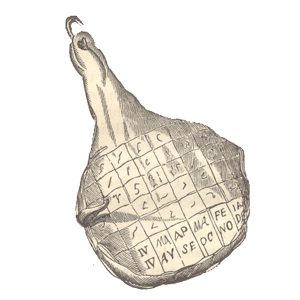 I have a question for you. What calendar do you use when interpreting the Bible’s prophetic record? Do you see “time” in the Bible through an Evangelical, Messianic, Hebrew Roots, Adventist, Catholic or some other denominational perspective? Can you give a reasonable explanation for your interpretational bias?
I have a question for you. What calendar do you use when interpreting the Bible’s prophetic record? Do you see “time” in the Bible through an Evangelical, Messianic, Hebrew Roots, Adventist, Catholic or some other denominational perspective? Can you give a reasonable explanation for your interpretational bias?
In my opinion the mechanics of “time” in the Biblical record is one of the most neglected aspects of Bible prophecy. It doesn’t matter whether you are one of today’s bestselling authors on Bible prophecy, a local pastor, or a layman like myself, few today can articulate a clear or reasonable understanding of how the Bible reckons “time” as it relates to the Bible’s prophetic record.
Some say the prophecies of the Bible should be interpreted using a solar year, others a lunar year and still others lunar/solar. Even more disconcerting is the fact that many prophecy teachers today use multiple and often conflicting calendars when interpreting the Bible’s prophetic record.
None of us like to miss appointments and as we draw closer to the Messiah’s return we need to ensure that we are reading our calendars correctly. Even if you believe you’re not going to be here for the final events of this age what about the people you leave behind? Will the calendar you have hanging on your wall provide them with an accurate understanding of the final prophetic events leading up to the Messiah’s return?
Today, I’d like to make an effort to bring a little bit of clarity to the calendar confusion. Hopefully by the time we are done you’ll have a more congruent understanding of Biblical “time” and how that “time” applies to the Bible’s prophetic record.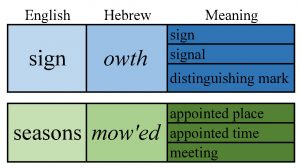
The Basics of Biblical Time
To get us headed in the right direction let’s first look at Genesis 1:14 where we have one of the first explanations of time in the Biblical record:
And God said, Let there be lights in the firmament of the heaven to divide the day from the night; and let them be for signs, and for seasons, and for days, and years: And let them be for lights in the firmament of the heaven to give light upon the earth: and it was so.
And God made two great lights; the greater light to rule the day, and the lesser light to rule the night: he made the stars also. And God set them in the firmament of the heaven to give light upon the earth, And to rule over the day and over the night, and to divide the light from the darkness: and God saw that it was good. (Genesis 1:14-18)
From this passage we learn that the sun rules the day and the “lesser light” (the moon) rules the night. We also learn that these lights are for “signs”, “seasons”, “days”, and “years”. As noted in the chart on the right the Hebrew words “signs” and “seasons” mean sign/signal and appointed times. Another way to look at this passage is the sun and moon are the signs and signals for the Bible’s appointed Holydays.
So in summary, the sun and moon are the means by which the Bible calculates days and years. They are also the means by which we determine YHWH’s signs or signals of His appointed times like the celebration of Passover, the Feast of Unleavened Bread, Firstfruits, the Feast of Trumpets, the Day of Atonement, and the Feast of Tabernacles. New moons and Sabbaths are also part of these “appointed times”.
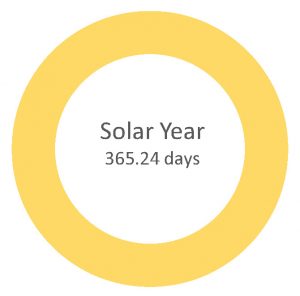 The Cycles of the Sun and Moon
The Cycles of the Sun and Moon
In today’s day and age we really don’t associate the sun and moon with time anymore. Most of us have a calendar hanging on our wall or more likely a phone in our pocket with a calendar on it. Time as we understand it today is a prefabricated template of 12 months within a 365.24 day year, but that is not how the Bible understood or even used “time”. Time as we learned above is based upon the sun and moon and their cycles. But how does it work? Well, let’s take a look:
The Biblical Day
The sun as all of us know is the brilliant yellow star in the sky which has risen and set every day of our lives. The reason the sun rises and sets (from our perspective) is because the earth is spinning at about 1000 miles an hour. Every 24 hours the earth makes one complete rotation, hence we perceive the sun to be rising and setting. This is the length of our day.
The Biblical Week
At creation YHWH organized these 24 hour days into cycles of 6 days of labor and 1 day of rest. Later in Biblical history this cycle of labor and rest was mandate![]() d to the children of Israel. Today we call this 7 day cycle of labor and rest a “week”.
d to the children of Israel. Today we call this 7 day cycle of labor and rest a “week”.
The Biblical (Solar) Year
Now if you thought the earth’s spin was fast, as they say, you haven’t seen nothing yet. While the earth is spinning at a 1000 MPH, it is also traveling around the sun at roughly 67,000 MPH. This circuit around the sun is what gives us the Biblical year. This Biblical solar year is 365.24 days in length.
The Biblical Seasons
As most of us know the earth’s circuit around the sun is not a perfect circle, it is really an ellipse. This elliptical circuit means that at different times of the year the earth is closer or farther away from the sun. This and the earth’s angle of inclination towards the sun are the reason we get different seasons.
In a solar year (365.24 days) the four seasons are just a bit over 52 weeks or in other words each season is 13 weeks (13×7) in length. For those of you who have read my book The 13th Enumeration: Key to the Bible’s Messianic Symbolism, you know this arrangement was no accident because I showed that the Bible’s calendar practically shouts to us of its Messianic symbolism and the13th Enumeration. But let’s not get sidetracked right here.
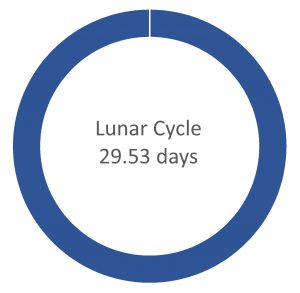 The Biblical (lunar) Month
The Biblical (lunar) Month
As we noted in Genesis 1:14 the Biblical calendar has two parts. The sun rules the day and as described above it is the basis for our days, weeks, and years. The moon, our “lesser light” rules the night and it is the 29.53 day cycle of the moon which is the basis of the Biblical months. These lunar months in the Bible are the fabric upon which the Bible’s holydays (mow’eds) or appointed times are built. Here is how King David understood it:
He appointed the moon for seasons [mow’ed]: the sun knoweth his going down. (Psalm 104:19)
Prophecies of the coming Messiah
In the Bible the month begins with the first visible light of the moon. Then for 13 or 14 days that light increases until the middle of the month when we get the full moon. It is at the end of the 14th day and the beginning of the 15th day of this waxing lunar cycle that two of the Bible’s “mow’eds or appointed times take place (Passover & Tabernacles). These Biblical holydays which are celebrated in the spring and fall are incredibly important in a Biblical sense because they are really embedded prophecies or “signs” which speak of the first and second coming of the Messiah Yeshua. Notice in the following passage how YHWH explains David’s “seed” shall endure forever and the moon is a faithful witness to that fact:
Once have I sworn by my holiness that I will not lie unto David. His seed shall endure for ever, and his throne as the sun before me. It shall be established for ever as the moon, and as a faithful witness in heaven. Selah. (Psalm 89:35-37)
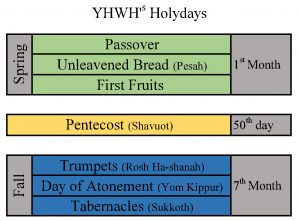 In the spring the lunar cycle determines when the Feast of Passover is celebrated. Passover over the millennia has become an all-inclusive description for the 7 day feast of Unleavened Bread. This mow’ed or appointed time begins with the Passover supper and includes a special holyday on the first and seventh day of the feast as well including the celebration of Firstfruits which begins the 50 day countdown to Pentecost. In the New Testament, Yeshua is clearly described as fulfilling these prophetic shadow pictures. Here are some examples:
In the spring the lunar cycle determines when the Feast of Passover is celebrated. Passover over the millennia has become an all-inclusive description for the 7 day feast of Unleavened Bread. This mow’ed or appointed time begins with the Passover supper and includes a special holyday on the first and seventh day of the feast as well including the celebration of Firstfruits which begins the 50 day countdown to Pentecost. In the New Testament, Yeshua is clearly described as fulfilling these prophetic shadow pictures. Here are some examples:
The next day John seeth Jesus coming unto him, and saith, Behold the Lamb of God, which taketh away the sin of the world. (John 1:29)
But now is Christ risen from the dead, and become the firstfruits of them that slept. (1 Corinthians 15:20)
By the which will we are sanctified through the offering of the body of Jesus Christ once for all. And every priest standeth daily ministering and offering oftentimes the same sacrifices, which can never take away sins: But this man, after he had offered one sacrifice for sins for ever, sat down on the right hand of God; (Hebrews 10:10-12)
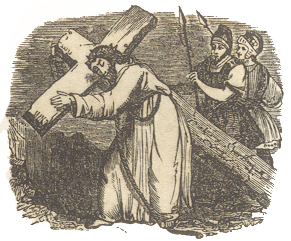 The Hope of Mankind
The Hope of Mankind
I like to look at it this way: Mankind for nearly six millennia now has labored under the curse of sin. This nearly hopeless state is regulated by the rising and setting of the sun, or in other words the solar side of the Bible’s calendar.
But there is hope!
For those who have appreciated the Biblical calendar over the millenniums, each night after our labor under the curse of sin we look up into the night sky and are reminded of where we are at in terms of YHWH’s prophetic calendar. This side of the Biblical calendar regulated by the cycles of the moon is what King David called a “witness” of YHWH’s mow’eds, these special Biblical holydays which speak to us of the Messiah’s redemptive sacrifice on our behalf. These lunar cycles also remind us of a yet future time when the Messiah will return and restore mankind and the earth to its intended state. Few verses in the Bible better describe the majesty of YHWH’s celestial display than Psalm 19:
The heavens declare the glory of God; and the firmament sheweth his handywork. Day unto day uttereth speech, and night unto night sheweth knowledge. There is no speech nor language, where their voice is not heard. Their line is gone out through all the earth, and their words to the end of the world. In them hath he set a tabernacle for the sun, Which is as a bridegroom coming out of his chamber, and rejoiceth as a strong man to run a race. Psalm 19:1-5
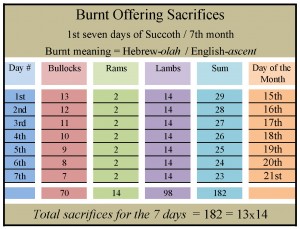 The Messiah Factors
The Messiah Factors
But we only scratched the surface, these celestial cycles also testify to YHWH’s redemptive purpose in another compelling manner.
For thousands of years now the visible light of the moon has waxed for 13 or 14 days and after a brief pause it then wains for another 13 or 14 days. These internal lunar cycles of waxing and waning light regulate the Bible’s festivals which themselves consist of sacrificial rites of 13 and 14. For more on this see my article The 14th Sacrifice or The Messiah Factors: Decoding 13 & 14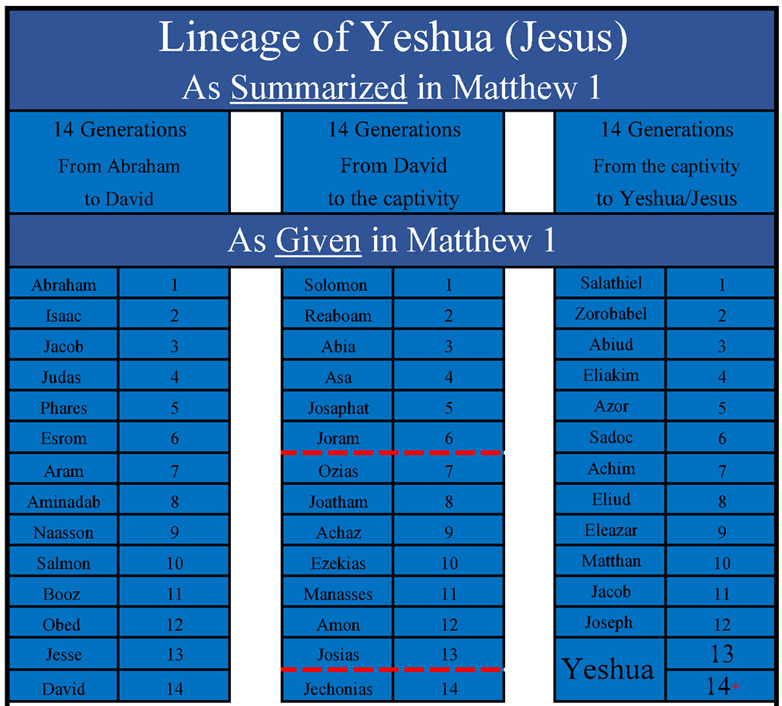
Are you beginning to glimpse the bigger picture here? The Bible’s calendar and lunar/solar cycles are a dazzling declaration of YHWH’s redemptive purpose for mankind through Yeshua the Messiah. This redemptive message is congruent throughout the sacrificial rights of the Old Testament, and it is confirmed by Matthew’s brilliant arrangement of Yeshua’s lineage into 13 & 14 generations. Further as demonstrated in Daniel’s 70 Weeks: The Keystone of Bible Prophecy, this symbolism is the key to unlocking the Biblical context of the Bible’s greatest messianic prophecy.
Reconciling the lunar and solar calendars
Okay, so the Bible’s calendar consists of a solar year of 365.24 days as well as lunar months of 29.53 days. But there is a bit of a problem. When you start accumulating lunar months in a solar year by the time you get to the12th month only 354.36 days have elapsed. In other words a 12 month Biblical lunar “year” is roughly ten days shorter than a solar year. Because the Bible mandates that the lunar cycles begin in the spring (Exo. 12:2) this ten day difference presents us with a challenge. How does the Bible reconcile both sides of YHWH’s calendar? Some of you have probable guessed by now, but yes the two sides of the Bible’s calendar are reconciled by a 13 month.
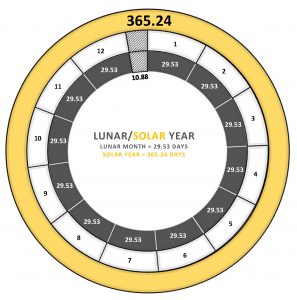 Here is another way to look at it. The rising and setting of the sun is the practical side of the calendar which regulates mankind’s struggles under the curse of sin. On the other hand the lunar cycles and the waxing and waning of the moon is the prophetic side of YHWH’s calendar which reminds mankind of their redemption and eventual restitution. Just as mankind’s sins are reconciled by Yeshua, the 13th enumeration of Matthew 1, in beautiful Biblical congruency the two sides of the Bible’s calendar are reconciled by a 13th month.
Here is another way to look at it. The rising and setting of the sun is the practical side of the calendar which regulates mankind’s struggles under the curse of sin. On the other hand the lunar cycles and the waxing and waning of the moon is the prophetic side of YHWH’s calendar which reminds mankind of their redemption and eventual restitution. Just as mankind’s sins are reconciled by Yeshua, the 13th enumeration of Matthew 1, in beautiful Biblical congruency the two sides of the Bible’s calendar are reconciled by a 13th month.
A 13th Month
The amazing symbolism of Biblical calendar aside, in practical terms a 13th month is an intercalation. This technical sounding word is something all of us are familiar with, only we call it be another name. All of us know about a “leap year”. Our leap year is derived from the fact that the solar year is 365.24 days in length and none of our calendar days take into account this ¼ (.24) of a day.
In order to fix this, once every four years we have to add a day back into the calendar. Our calendars do this by inserting one extra day in February. Thus February 29th becomes intercalary or a “leap year”. This extra day keeps the calendar month of January from wandering through the seasons. You see if this .24 of a day was left unaccounted for then in only 120 years the month of January would start where the month of December once did. In 700 years January would fall in the middle of summer. So you see intercalations are important.
YHWH reconciles the Calendar
It is important here to comprehend the 13th month in terms of the larger Biblical context. When Israel left Egypt, they were familiar with the Egyptian calendar year. We know from Egyptian archeological evidence that some Egyptian dynasties kept a lunar calendar with 30 day months thus making their “lunar” year 360 days in length. These calendars became known as vague or wandering because they were not intercalated with the sun’s solar cycle to account for the missing 5.24 days. So in other words, much like the Islamic calendar today the months wandered through the seasons.
 But YHWH did not intended for the Biblical calendar to wander without an intercalation. When Israel left Egypt YHWH commanded them to begin their months in Abib. Abib in the Bible is simply a term which describes the ripeness of barely. Barley in Egypt and Israel is “abib” in spring. Spring in turn is determined by the earth’s position relative to the sun. So by fixing the lunar cycles relative to the ripeness of barley (and thus the solar year), YHWH gave Israel a layman’s intercalation. When the 12th lunar month rolled around each year Israel simply had to look at the barley to see if it was “abib”. If not, then they added a 13th month. Because of the ten day difference between the lunar and solar cycles a 13th month is needed approximately every three years.
But YHWH did not intended for the Biblical calendar to wander without an intercalation. When Israel left Egypt YHWH commanded them to begin their months in Abib. Abib in the Bible is simply a term which describes the ripeness of barely. Barley in Egypt and Israel is “abib” in spring. Spring in turn is determined by the earth’s position relative to the sun. So by fixing the lunar cycles relative to the ripeness of barley (and thus the solar year), YHWH gave Israel a layman’s intercalation. When the 12th lunar month rolled around each year Israel simply had to look at the barley to see if it was “abib”. If not, then they added a 13th month. Because of the ten day difference between the lunar and solar cycles a 13th month is needed approximately every three years.
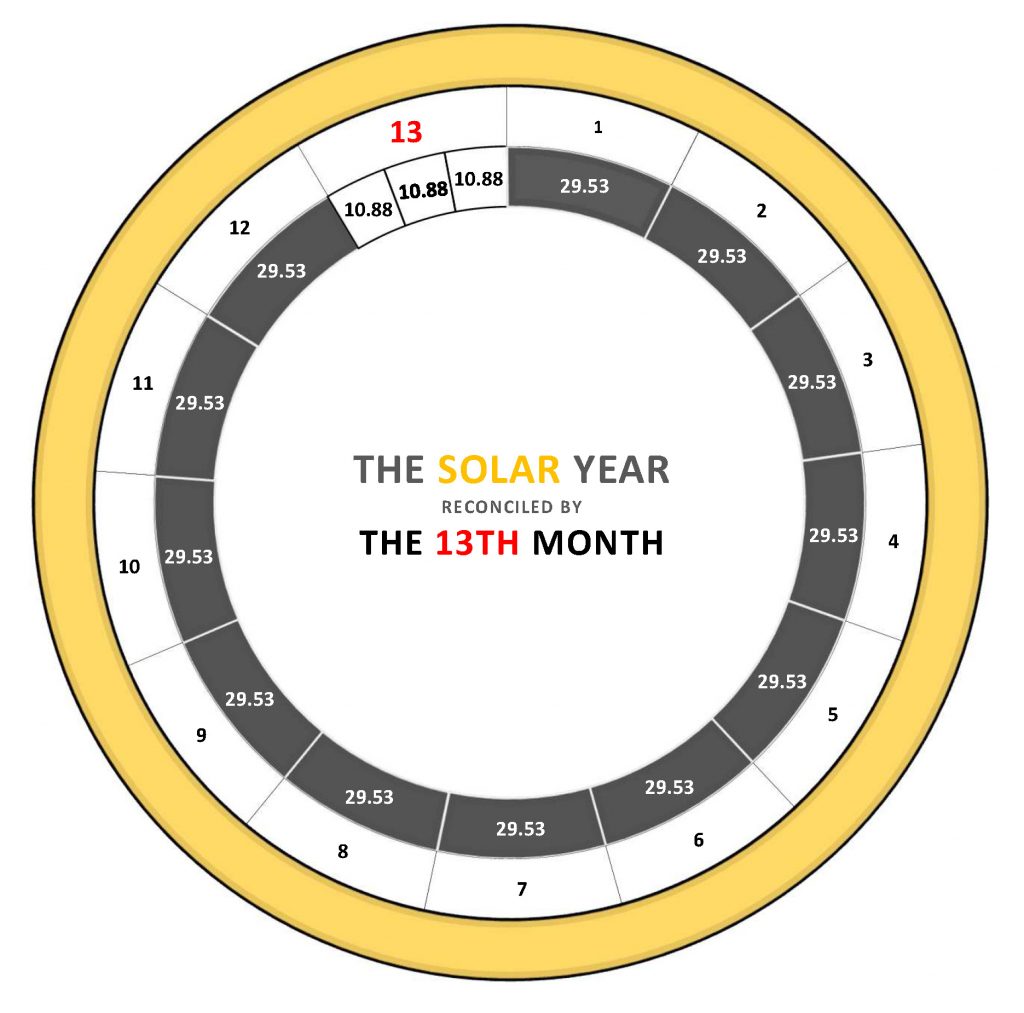 Please note the chart does not reflect the correct
Please note the chart does not reflect the correct
starting point of the 1st month. (It should overlap the 13th month.)
The feast of unleavened bread shalt thou keep. Seven days thou shalt eat unleavened bread, as I commanded thee, in the time of the month Abib: for in the month Abib thou camest out from Egypt. (Exodus 34:18)
This month [Abib] shall be unto you the beginning of months: it shall be the first month of the year to you. (Exodus 12:2)
For those interested in a Biblical example of a 13th month check out my article on Ezekiel’s 13th Month. For more on Israel, Egypt, and the calendar issues see: Halloween and the Bible or part II of that series, The Flood & the Coming Messiah
Historical Evidence confirming the Abib Intercalation
As an aside archeologists and historians were recently surprised to learn that ancient Bronze Age peoples really did intercalate their calendars with a 13th month (as implied by Exodus 12:2).
In 1999 an artifact called the Sky Disk of Nebra was found in Saxony Germany which dated to 1600 BC. This disc, archeologists discovered, was the earliest known example o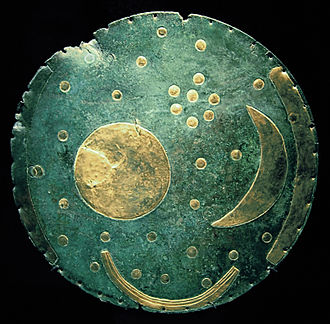 f astronomical instrument which intercalates the lunar/solar cycles with a 13th month. In Biblical chronology, 1600-1500 BC takes us back to Moses and the Exodus of Israel from Egypt.
f astronomical instrument which intercalates the lunar/solar cycles with a 13th month. In Biblical chronology, 1600-1500 BC takes us back to Moses and the Exodus of Israel from Egypt.
This disk is just one historical example that confirms the Biblical calendar, as observed in the heavens today (365.24 day year / 29.53 day month), was the same celestial calendar YHWH instructed Israel to use when they exited Egypt.
The Biblical Calendar Confirms the Messiah
In summary then, the sun and moon and their relationship to the earth are the gears which drive YHWH’s calendar. Long ago they were precisely tuned so that they would confirm for mankind that Yeshua was the Messiah promised in the Biblical record. Ever since then they’ve been declaring “the glory of God”, Yeshua the promised Messiah.
Indeed this very message is confirmed with firsthand eyewitness accounts which tell us that Yeshua fulfilled the very essence of the biblical spring holydays at His first coming. Further the lineage of Yeshua as arranged by Matthew, the number and order of the sacrificial rites in the Old Testament, and the prophecy of Daniel 9 all provide a congruent picture of this Messianic symbolism.
Calendar Confusion
But that is not the end of the story. Today many Biblical scholars and teachers believe the prophecies of the Bible are best explained by using a different calendar than the one described above. They propose a calendar which severs the clear messianic symbolism embedded in the cycles of YHWH’s celestial mechanics. Calendars such as Sir Robert Andersons’ 360 day lunar “prophetic” year. Still others believe the Bible’s prophetic word should be understood in light of a strictly solar calendar of 365.24 days.
Our next article will look at these calendars and explain why they do not measure up to a Biblical reckoning of time. I think you’ll be surprised to learn about the underlying evidence and assumptions used to support such variations on the Biblical calendar and the profound implications these assumptions have had on our interpretations of the Bible’s prophetic record.
I look forward to continuing the adventure with you!
Part II – Calendar Confusion and the Bible’s Prophetic Record
* * *

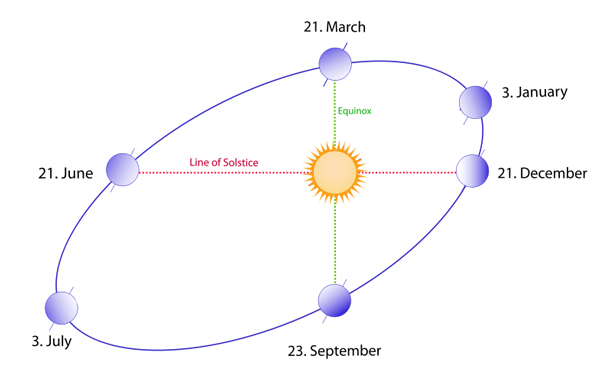



Wonderful article, William. You have a gift of expressing fairly complex ideas in an easy -to-understand manner. God bless you and your work, thank you for sharing!
Good afternoon Stephen,
Thank you for the kind words, Stephen. I’m thrilled you enjoyed the article. YHWH gets all the credit though. I’m just a high school educated plumber with callused hands.
Warm regards,
William
Correct. There is no 360-day year via Biblical reckoning of time. Yet, so many writing on the subject pull out a 360-day year.
Are you familiar with this writer on the subject of Biblical time?
https://www.wake-up.org/end-times-prophecy/end-of-time-charts/bible-charts-index.html
Hi Ben,
No I’m not familiar with the site. Thanks the link.
Warm regards,
William
It’s rather interesting reading. Larry Wilson is the author and I’ve read 2 or 3 of his books.
I can’t say I agree with all his prophetic interpretations. But, the historical-to-Biblical correlation is well researched.
I really enjoy your articles. Hope you’ll do more.
Regards,
Ben
Dear sir,
Basically then, it is the Lunisolar Calendar that determines all of YHWH’s biblical feasts days including the Sabbath. I’m glad that I do have one such calendar displayed in my home. On it, the first visible light of the moon, several hours after conjunction, is determined a New Moon Day. This is followed by Day 1 up to Day 6, all working days. Day 7, which is the 8th of the month, is Sabbath. Three other Sabbaths follow on the 15th, 22nd and 29th. There are only four Sabbaths in every lunation or lunar cycle and they always occur on those dates. All the seven spring and fall feasts of YHWH are easily determined on this calendar.
Of course, since we use the Gregorian calendar as our universal method of timekeeping, the Sabbaths wander around the week. This is a challenge as they tend to fall on working days. On those days, I acknowledge YHWH as the Creator and give thanks and praise to Him that created the heavens and the earth.
I really enjoy reading your blogs. I have a question for you regarding Noah’s flood. God gave us the month and the day it started and Jesus told us in Matthew 24 that the Days of Noah would be a sign of his return. Could it be that he gave us this information for a reason?? By that I mean, does the month and day that the flood started mean anything for the time of his return.?? There is such a detailed record of the flood, when it started, how long it lasted ect. I am not a mathmatic person at all. I am hoping since you are so good at this kind of thing that you might be able to shed some light on what I believe might be very important for us to know?? Thanks so much!!